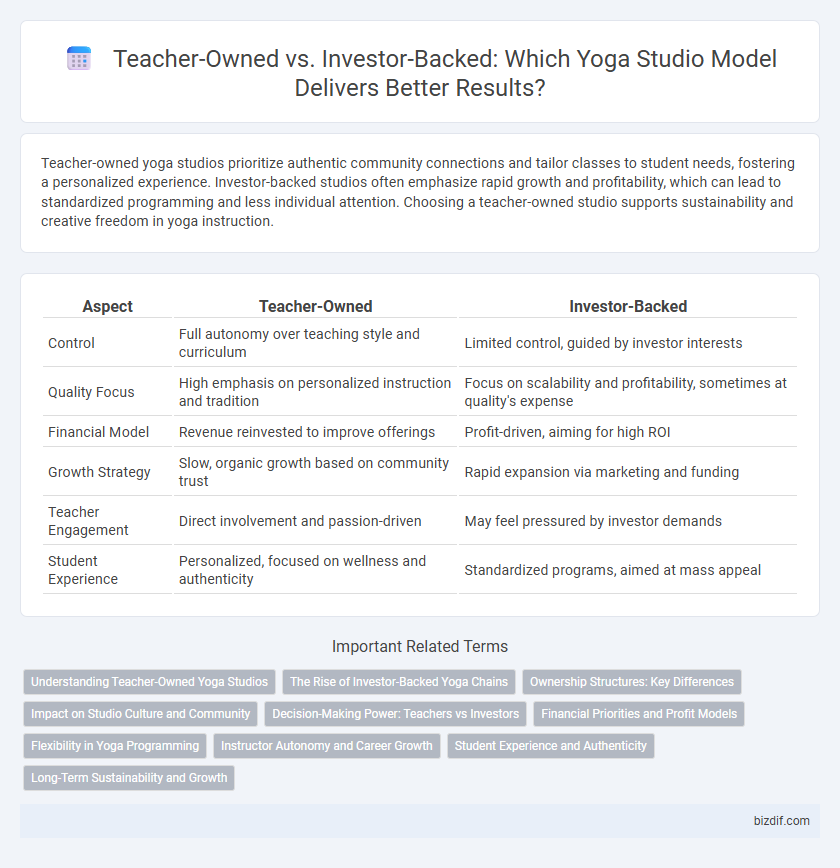Teacher-owned yoga studios prioritize authentic community connections and tailor classes to student needs, fostering a personalized experience. Investor-backed studios often emphasize rapid growth and profitability, which can lead to standardized programming and less individual attention. Choosing a teacher-owned studio supports sustainability and creative freedom in yoga instruction.
Table of Comparison
| Aspect | Teacher-Owned | Investor-Backed |
|---|---|---|
| Control | Full autonomy over teaching style and curriculum | Limited control, guided by investor interests |
| Quality Focus | High emphasis on personalized instruction and tradition | Focus on scalability and profitability, sometimes at quality's expense |
| Financial Model | Revenue reinvested to improve offerings | Profit-driven, aiming for high ROI |
| Growth Strategy | Slow, organic growth based on community trust | Rapid expansion via marketing and funding |
| Teacher Engagement | Direct involvement and passion-driven | May feel pressured by investor demands |
| Student Experience | Personalized, focused on wellness and authenticity | Standardized programs, aimed at mass appeal |
Understanding Teacher-Owned Yoga Studios
Teacher-owned yoga studios emphasize authentic practice and community connection, often reflecting the values and teaching styles of their instructors. These studios prioritize student experience and cultivate a supportive environment by reinvesting profits into quality instruction and studio upkeep. Understanding this model highlights its commitment to personalized guidance and long-term sustainability over rapid financial growth.
The Rise of Investor-Backed Yoga Chains
Investor-backed yoga chains have rapidly expanded, leveraging significant capital to scale operations and standardize class offerings across multiple locations. These chains focus on brand consistency, technology integration, and aggressive marketing strategies to capture market share from traditional teacher-owned studios. The increased presence of investor-backed entities has transformed the yoga industry, prioritizing profitability and accessibility over the personalized experience often found in teacher-owned settings.
Ownership Structures: Key Differences
Teacher-owned yoga studios emphasize personal control and community connection, allowing instructors to directly influence class offerings and studio culture. Investor-backed studios typically prioritize scalability and profit, driven by stakeholders focused on financial returns rather than personalized teaching experiences. Ownership structures impact decision-making processes, resource allocation, and long-term goals within the yoga industry.
Impact on Studio Culture and Community
Teacher-owned yoga studios often cultivate a deeply personal and authentic studio culture, emphasizing holistic well-being and community connection through personalized instruction and values-driven leadership. Investor-backed studios may prioritize rapid growth and profitability, which can dilute the sense of community and shift focus towards standardized classes and commercial goals. Maintaining a vibrant studio culture is essential for fostering trust, loyalty, and long-term engagement among yoga practitioners.
Decision-Making Power: Teachers vs Investors
Teacher-owned yoga studios grant instructors full decision-making power over class offerings, studio culture, and community engagement, aligning operations closely with teaching philosophies and student needs. Investor-backed studios often involve investors in key decisions, prioritizing profitability and growth metrics, which can limit teachers' influence on curriculum and studio environment. This fundamental difference impacts how yoga instruction is delivered and how responsive studios are to the evolving needs of their practitioners.
Financial Priorities and Profit Models
Teacher-owned yoga studios prioritize sustainable growth and community-focused financial strategies, often reinvesting profits into class quality and instructor development. Investor-backed studios emphasize rapid scaling and maximizing profit margins, frequently implementing membership models and diversified revenue streams. Understanding these financial priorities helps practitioners choose between personalized experiences in teacher-owned spaces and the expansive offerings typical of investor-backed studios.
Flexibility in Yoga Programming
Teacher-owned yoga studios offer unparalleled flexibility in yoga programming, allowing instructors to tailor classes to the unique needs of their community without external constraints. Investor-backed studios often prioritize standardized classes and profitability, limiting the ability to experiment with innovative or niche yoga styles. This autonomy in teacher-owned models fosters a more personalized and diverse practice environment.
Instructor Autonomy and Career Growth
Teacher-owned yoga studios offer instructors greater autonomy to design classes and develop personalized teaching styles, fostering organic career growth and deeper community connections. Investor-backed studios often impose standardized class structures and schedules, which can limit creative freedom but provide more stable financial resources and marketing support. Balancing instructor autonomy with business scalability remains a critical challenge in the evolving yoga industry.
Student Experience and Authenticity
Teacher-owned yoga studios prioritize personalized student experiences, fostering deeper connections and maintaining authentic teaching styles rooted in traditional practices. Investor-backed studios often emphasize scalability and standardized classes, which can dilute the authenticity and individual attention students receive. This contrast impacts overall student satisfaction and the preservation of genuine yoga philosophies.
Long-Term Sustainability and Growth
Teacher-owned yoga studios foster long-term sustainability by centering decisions on authentic community values and consistent class quality, ensuring steady student retention and organic growth. Investor-backed studios prioritize rapid expansion and profitability, which may risk compromising the personalized experience essential for enduring client loyalty. Balancing financial resources with teacher-led vision is crucial for sustainable growth that respects both business viability and the integrity of yoga instruction.
Teacher-owned vs Investor-backed Infographic

 bizdif.com
bizdif.com